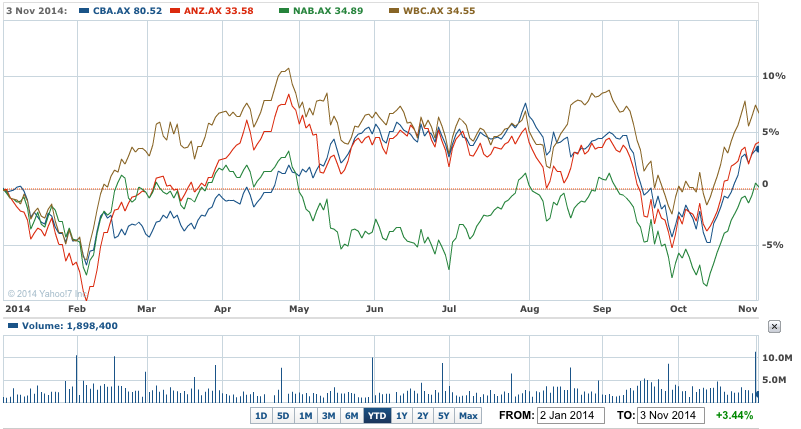Westpac (WBC) wrapped up the bank reporting season yesterday and a muted end was had by all in contrast to the strong gains seen around the interim reports in May, and a year ago for the 2012-13 full year figures.
In fact the results from the National Australia Bank (NAB), Westpac, ANZ, Bank of Queensland (BOQ) and Macquarie (MQG) collectively failed to shift investor sentiment towards the banks which seems to be more sceptical than it has been for more than a year.
That scepticism is related to a combination of fears about the sustainability of the solid profit and income growth the big four have been showing for the past five years (with the exception of the NAB which is starting to lag noticeably).
On top of that there are fears the banks might be hit by higher capital calls from the Financial System Inquiry being headed by former CBA CEO, David Murray, which reports to the government later this month.
Westpac shares lost 0.7% yesterday despite the small rise in final dividend and an 8% rise in cash profit to an all time high.
The $34.55 price at the close was well under the record of $35.99 reached a couple of months ago.
ANZ shares rose 0.2% to $33.58 (all time high was $35.07), while NAB shares fell 0.3% to $34.89 ($36.54 high).
Shares in the Commonwealth Bank (CBA) edged up 0.1% to $80.52 (all time high $83.92).
The CBA releases a trading update tomorrow and not at the bank’s AGM next Wednesday.
The Big 4 YTD – Banking correction short-lived but hurdles remain

Collectively, the CBA, NAB, ANZ and Westpac earned record cash net profits of $28.6 billion in 2013-14, up 5.7% from the 2012-13 figure.
The NAB was the only major bank to post a reduced profit, thanks to $1.3 billion in higher provisions inits UK banks for miss-selling financial products (but it is now looking to exit its Clydesdale and Yorkshire Banks).
Accounting firm KPMG said in its annual look at the big four that strong property prices, historically low loan impairments and improved wholesale funding conditions helped drive the higher collective returns of the big banks.
“The 2014 full year saw the majors sustain their current level of high returns, underpinned by robust growth in housing credit and wealth management, further declines in bad and doubtful debt charges, lower wholesale funding costs and continued cost discipline,” the group’s national head of banking Ian Pollari said in a statement.
Much of the rise in profits came from lower bad debt provisions, which collectively fell $1.6 billion to $3.4 billion. Net interest margins again fell to an average 2.07 cents in the dollar (The NAB was the lowest with $1.94 cents).
Return on equity also eased (driven by the weak result from the NAB). But the banks’s low cost to income ratios remain intact (excusing the one off rise for the NAB to 53 cents in the dollar because of the $1.3 billion in impairments and extras provisions). The big four had an average cost to income ratio of 45.9%, but would have been closer to 43% had it not been for the NAB.
Net interest income including wealth management and insurance businesses, fees and commissions, and financial markets increased by $2.2 billion to $25.5 billion, a rise of 9.4%.
Housing credit is growing at an annual pace of 7.2%, led by strong demand from in Sydney especially, followed by Melbourne.
The CBA was again tops – by a very long way – a billion dollars over Westpac.
• CBA earned a profit of $8.68 billion, up 12% from $7.82bn in 2012-13;
• Westpac $7.63 billion, up 8% from $7.06bn;
• ANZ earned $7.12 billion, up 10% from $6.49bn;
• NAB saw its profit fall to $5.18 billion, down 10% from $5.75b.













